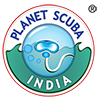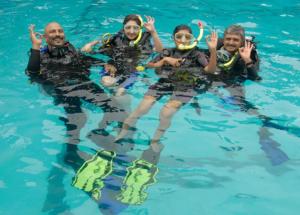In the PADI Rescue Diver dvd they call it ‘Serious Fun’ when it should be more accurately titled “Seriously tiring”. It isn’t just the physical aspects of the rescue diving course that tires you out. The mental aspects of being constantly alert to danger is what takes the toll on you. But it is not all gloom and doom. The course itself is very fun. It has its moments of sheer slapstick comedy you could only find on a television sitcom.
My course was a devious plot from the start. I had been informed that my open water scenarios would be held a day later. So i was pretty much not thinking about it while enjoying my 2 fun dives. Well, that is abit of a stretch. My first fun dive left me scratched from trying to do a walrus beach assault speciality(that is a whole different story) So i was taken by surprise when someone while snorkelling suddenly shouted he had a cramp and was struggling. It didn’t strike me yet that it was a test so i responded as the training instructed. Stop Breathe Act. I didn’t jump into the water straightaway as what i would have done. I looked around the boat and found a life buoy with rope attached and swung it out. Sure after that i had to swim in and rescue a “panicked” snorkeller. The devious part was that the instructor didn’t wait for me to heal up from my scratched incident at the rocks. He cunningly used that as a stress test and threw me into the fire. It was a good thing i was pretty ready.
The fun didn’t end after that, there were 2 more scenarios thrown in before we headed back to the jetty. Heck, while at the jetty there was a YET another incident. This time in full view of spectators waiting for the next ferry. So there was panicked shouting from the stands as an added realism bonus. After a successful save there was even applause. The final scenario was held the next day. I have to say that it wasn’t as easy. The only way you can ever be 100% prepared to handle an emergency is to train for it every single day. But when scuba diving is concerned there is no such thing as 100% sure. There will be some elements to shake things up abit. I remembered what a Divemaster on the boat told me while i was preparing to go out and make a save. ” Don’t worry about doing all the right things. Doing a save half prepared is better than NOT doing a save at all”
I am glad i went through the course. It has taught me a valuable lesson in keeping my head together and not panicking. It also allowed me to see my first shark ever. Now THAT IS SERIOUS FUN!
Zero to Advance
How long does it take to go from a non diver to a PADI-Advanced Open Water Diver? All it takes is 5 Days. WHAT?? NO WAY!! IMPOSSIBLE? It’s true. just 5 days.
It begins with 2 days of classroom lessons and pool sessions. Then take a 3 days relaxing trip to the Andamans and completing 9 dives and getting qualified as an Advanced Open Water Diver. Sure you can take the same time do a even more relaxing holiday and get qualified as an PADI-Open Water Diver. But this is me we are talking about. We got to go the whole way or no way.
But i will tell you this, it was a beautiful experience. The classroom sessions give you a feel of what to expect. I shall be honest and say some parts of it were dry but hey all classroom lessons are generally on the dry side. The pool sessions however were good. You get to learn the basic skills in a safe and conducive environment. It puts you at ease and gets you acquainted with the equipment that you will use in the open waters. Also its the best excuse to cool yourself off in this summer heat.
PADI-Open Water Diver: The first 2 days in the island was spent getting certified as a OWD ( we use short forms from here on cos, for one thing it sounds cooler. 2ndly i can’t be bothered to type out the whole thing) The first time you are on the boat and putting on your gear, there is a fleeting moment in the back of your head which says ” am i doing the right thing?” that fleeting moment soon disappears when you roll backwards from the boat to the water and is replaced with a siren that goes ” HOLY *#*$&# what the hell is happening” But when you surface and are lazily floating, you realise this IS the life.
You begin the first couple of lessons learning to breathe normally and adjust to your surroundings. You start to feel comfortable in the water. It feels as if you are back home. You gain more confidence moving around. You start to enjoy yourself. Then it hits you. You are breathing underwater. It seems like almost 2nd nature to you. You see the corals and the fishes. This seems like the most natural thing to do. The OWD course teaches you to move underwater, performing tasks that you need to learn. Like defogging your mask (we are waiting for them to create mini internal windshield wipers) learning how to be buoyant so that you don’t crash land on top of aquatic life. You learn and enjoy yourself at the same time. It does not get better than this.
AOWD(Advanced Open Water Diver) shall be continued in my next installment. But first i shall leave you with some pictures.
Do your part
24th Feb 2009 is the next PADI- Open Water Diver Course. Sign up with us now, so that your summer holidays will be a fun filled scuba diving one. But to more serious news.
One Fifth of World’s Corals Gone: Climate Change Battle to Rescue Remaining
The Status of Coral Reefs of the World: 2008, released in Washington, DC, December 2008, declares a 19 percent loss of coral reefs worldwide.
Launched by the Global Coral Reef Monitoring Network (GCRMN), the report identifies which coral reefs are recovering and which are declining worldwide. The report states if current trends in carbon dioxide emissions continue, many remaining reefs may be lost over the next 20 to 40 years with alarming consequences.
Project AWARE Foundation, partner behind the project and supporter of the launch event, is encouraged by the report that 45 percent of the world’s reefs are currently healthy. But the Foundation also recognizes a focus on climate change, now considered the leading threat to coral reefs today. Threats including increasing ocean temperatures and ocean acidification are intensified by other threats including overfishing, pollution and invasive species.
“If nothing changes, we are looking at a doubling of atmospheric carbon dioxide in less than 50 years,” says Carl Gustaf Lundin, Head of the IUCN Global Marine Programme, one of the organizations behind the Global Coral Reef Monitoring Network. “As this carbon is absorbed, the oceans will become more acidic, which is seriously damaging a wide range of marine life from corals to plankton communities and from lobsters to seagrasses.”
Hope is also found in the ability of some corals to recover after major bleaching events, caused by warming waters, adapting to climate change threats. However, the report also shows the recent downward trends have not been reversed in the last four years. And corals have a higher chance of survival against climate change if other human threats are minimized.
“The report details the strong scientific consensus that climate change must be limited to the absolute minimum. If nothing is done to substantially cut emissions, we could effectively lose coral reefs as we know them, with major coral extinctions,” says Clive Wilkinson, Coordinator of the Global Coral Reef Monitoring Network.
“Ten years after the world’s biggest coral bleaching event, we know that reefs can recover given the chance. Unfortunately, impacts on the scale of 1998 will reoccur in the near future, and there’s no time to lose if we want to give reefs and people a chance to suffer as little as possible,” says Dr David Obura, Chair of the IUCN Climate Change and Coral Reefs working group and Director of the Coastal Oceans Research and Development in the Indian Ocean Programme (CORDIO) in East Africa.
The GCRMN is a network of people, governments, institutes and NGOs in more than 80 countries, with many partners, including: CORDIO, Reef Check, CARICOMP, Project AWARE Foundation and AGRRA. All reports are available through www.ReefBase.org. To read more of such articles visit ProjectAware
Drink & Dive

Drink and Dive!
Dear Divers,
Planet Scuba India would like to invite you for an informal
gathering to Kick off Bangalore Divers Club to introduce ourselves and each other and also to discuss about upcoming 2009 dive trips. The Venue and other details are mentioned below:
Date: 21st January 2009 (Wednesday)
Time: 7.30 p.m.
Venue :Xtreme Sports Bar
No.765, 4th Floor, 100 Feet Road,
HAL II Stage, Indiranagar, Bangalore – 38.
Phone No. 080-42407777/7788
(Landmark – near to Sony World and above Raid & Taylor showroom)
We hope to see you there. Let’s have a drink and talk about diving for 2009!
The Need For Contained Water Dive Schools
Scuba diving has always been associated with deep blue seas, glorious coral reefs, breathtaking underwater sceneries and psychologically, a momentary escape from the drudgeries of life above water. Not everyone can don the wet suit and take a dive in the open waters for the first time, though. It takes a lot of practice to be able to do this, apart from the required certifications. Perhaps the best way to start training for the big dive is inside a swimming pool, where the environment is controlled and there are no surprises for the novice divers.
PADI (Professional Association of Diving Instructors) strongly recommends dive schools around the world to train students in contained waters before taking them out to open waters. One of the main reasons for this would be to combat the initial hesitation and apprehension of students about to dive for the very first time. Apart from the fact that training in a swimming pool is safer it is also easier for instructors to maintain control over the students’ equipment as well as their own.
There is also the psychological aspect of diving to consider. People’s paranoia about sharks and other undersea creatures, fueled by Hollywood, does play an important role in the speed at which a student learns the nuances of breathing and staying calm underwater.
Controlling the rate of descent and staying stable at the desired depth are two other important aspects that can be addressed in contained water dives. There are no extraneous waves and sudden currents that would affect the balance of the diver, and this makes life that much easier for the instructor in training the student.
“It’s all a matter of what’s best for the students,” says Mr. Madhava Reddy, director of Planet Scuba India, which recently launched the country’s first inland scuba divind school in Bangalore. “Our PADI 5-star swim center complimented by the dive center at the KC Reddy Swim Centre and the expertise of out trainers makes our diving school one of the safest. Contained water dives are the best way and of course, the safest way for someone to learn diving and to build the required confidence to dive in open waters,” he added.

